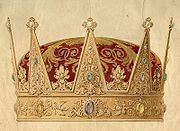
Crown Prince Carl's Crown
Encyclopedia

Crown (headgear)
A crown is the traditional symbolic form of headgear worn by a monarch or by a deity, for whom the crown traditionally represents power, legitimacy, immortality, righteousness, victory, triumph, resurrection, honour and glory of life after death. In art, the crown may be shown being offered to...
of Crown prince
Crown Prince
A crown prince or crown princess is the heir or heiress apparent to the throne in a royal or imperial monarchy. The wife of a crown prince is also titled crown princess....
is one of the Norwegian Royal Regalia
Norwegian Royal Regalia
The crown jewels, or royal regalia, of Norway include nine items: the king's crown, the sword of the realm, the king's sceptre, the king's orb, the queen's crown, the queen's sceptre, the queen's orb, the crown of the crown prince and the anointing horn...
.
The crown was made in 1846, designed by Johannes Flintoe
Johannes Flintoe
Johannes Flintoe was a Danish painter who spend most of his career in Norway, both painting and teaching. He is known for landscapes and scenes from Scandinavian history.-Biography:Flintoe was born in Copenhagen in 1787...
based on a crown dating from the Middle Ages
Middle Ages
The Middle Ages is a periodization of European history from the 5th century to the 15th century. The Middle Ages follows the fall of the Western Roman Empire in 476 and precedes the Early Modern Era. It is the middle period of a three-period division of Western history: Classic, Medieval and Modern...
, and commissioned to the goldsmith Herman Colbjørnsen Øyset. It was originally made for crown prince Carl, later King
King
- Centers of population :* King, Ontario, CanadaIn USA:* King, Indiana* King, North Carolina* King, Lincoln County, Wisconsin* King, Waupaca County, Wisconsin* King County, Washington- Moving-image works :Television:...
Carl XV
Charles XV of Sweden
Charles XV & IV also Carl ; Swedish and Norwegian: Karl was King of Sweden and Norway from 1859 until his death....
of Sweden
Sweden
Sweden , officially the Kingdom of Sweden , is a Nordic country on the Scandinavian Peninsula in Northern Europe. Sweden borders with Norway and Finland and is connected to Denmark by a bridge-tunnel across the Öresund....
and Norway
Norway
Norway , officially the Kingdom of Norway, is a Nordic unitary constitutional monarchy whose territory comprises the western portion of the Scandinavian Peninsula, Jan Mayen, and the Arctic archipelago of Svalbard and Bouvet Island. Norway has a total area of and a population of about 4.9 million...
. It was meant to be used by Carl when his parents Oscar I and Josephine
Josephine of Leuchtenberg
Joséphine of Leuchtenberg was Queen consort of Sweden and Norway as the wife of King Oscar I...
were crowned, but the ceremony never took place.
It is the only piece of Norway's coronation regalia to be made entirely within Norway, and it has never been worn.
It is a crown of the open type with spikes. It weighs a little over 1kg, and contains a green peridot
Peridot
-Chemistry:The chemical composition of peridot is 2SiO4, with Mg in greater quantities than Fe.-Etymology:The origin of the name "peridot" is uncertain...
, freshwater pearls and an amethyst
Amethyst
Amethyst is a violet variety of quartz often used in jewelry. The name comes from the Ancient Greek ἀ a- and μέθυστος methustos , a reference to the belief that the stone protected its owner from drunkenness; the ancient Greeks and Romans wore amethyst and made drinking vessels of it in the belief...
.

